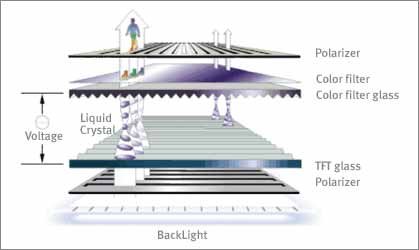

Liquid-Crystal displays (LCD) are flat electronic video displays that use the light modulation properties of liquid crystals.
LCD displays do not produce light; so to generate brightness, LCD displays have a backlight. A backlight is a small fluorescent lamp placed behind, above, or to the side of an LCD display. The light from the lamp is diffused across the screen, producing brightness. The typical laptop display uses a cold cathode fluorescent lamp (CCFL) as its backlight. They're generally about eight inches long and slimmer than a pencil. They generate little heat.
The only problem with fluorescent lighting used as LCD backlights is that they require fairly high-voltage, often 500 - 700V, and produce high-frequency energy. An inverter is needed to provide the the high voltage. The inverter is a small circuit board installed behind the LCD panel that takes DC power and converts it to power the backlight. If you are having problems with flickering screens or dimness, it's could be the inverter or the lamp is the problem.
Flat panel displays use multiplex addressing to drive pixels, because of all the pixels involved. When the elements are in a regular order, as they are with monitors (top row selected first, then 2nd row, etc; left most pixel in a row first, right most pixel last in a given row) they can be addressed by their row and column instead of each element being driven separately. This reduces the complexity of the circuitry because each pixel no longer needs its own driver circuit. If you have a 1000 x 1000 matrix of pixels, with direct addressing, you need 1 million individual drivers. However, with multiplex addressing, you only need 2000 drivers, one for each row and one for each column. These rows and columns form a matrix.
There are two types of matrix displays: Active and passive.
The passive matrix display is addressed by a set of multiplexed transparent electrodes, perpendicular to one another, above and below the liquid crystal layer in a row and column formation as seen below. The electrodes are typically constructed of indium tin oxide (ITO) which is a semi-transparent conducting material. A passive pixel is addressed when there is a sufficient voltage across it to cause the liquid crystal molecules to align parallel to the electric field. Sufficent voltage occurs when the horizontal row electrode towards the front, and the vertical column electode are both on. When both are on a particular pixel is energized to allow light through. A display can have more than one pixel on at any one time because of the response time of the liquid crystal material. When addressed, a pixel has a short turn-on time during which the liquid crystal molecules align in such a way as to make the pixel opaque. When the voltage is removed the pixel behaves similar to a discharging capacitor, slowly turning off as charge dissipates and the molecules return to their undeformed orientation. As long as the pixel is off by the time the next frame occurs all is OK.
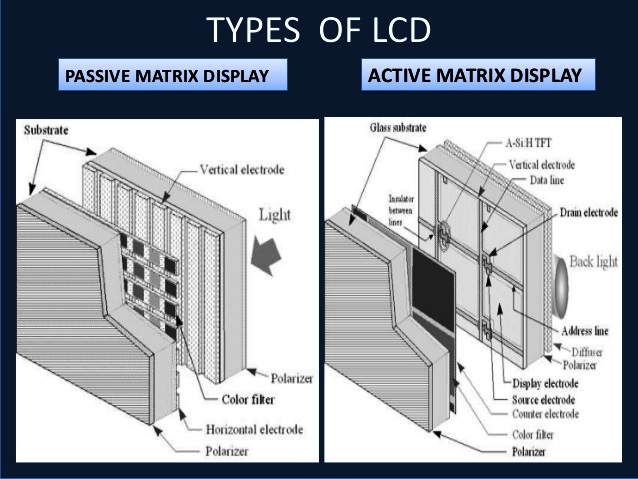
Active matrix displays are found in high end LCD monitors. In this type of display, the addressing takes place completely behind the liquid crystal film as can be seen above. The front surface of the display is coated with a continuous transparent electrode while the rear surface electrode is patterned into individual pixels. Individual thin film transistors (TFT) acts as the switch for each pixel. The TFT is addressed by a set of narrow multiplexed electrodes (gate lines and source lines - one for rows and the other for columns) running along the gaps between pixels. A pixel is addressed by applying current to a gate line which switches the TFT on and allows charge from the source line to flow on to the rear electrode. This sets up a voltage across the pixel and turns it on. An image is created similar to the passive display as the addressing circuitry scans across the matrix. An active matrix display does not suffer from many of the limitations of the passive display. It can be viewed at an angle of up to 45 degrees and has a contrast of 40:1, meaning that the brightness of an "on" pixel is 40 times greater than an "off" pixel. It does, however, require a more intense back lighting system because the TFT's and the gate and source lines are not very transparent and therefore block a fraction of the light.
Today some LCD monitors use LED displays to provide the backlight. These monitors are known as LED monitors. LED displays are generally thinner and weight less than LCD monitors because of the LED backlighting and they use less power. LCD offer more contrast creating more vivid video. The fluorescent lamps used for backlighting tend to have lifespans of five to six years while LEDs will generally last much longer.
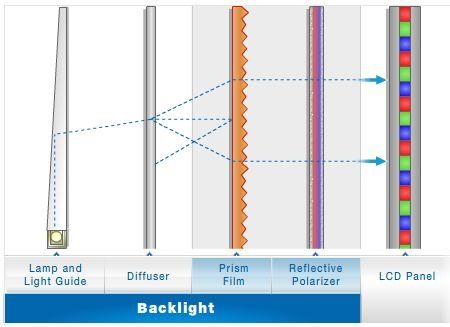
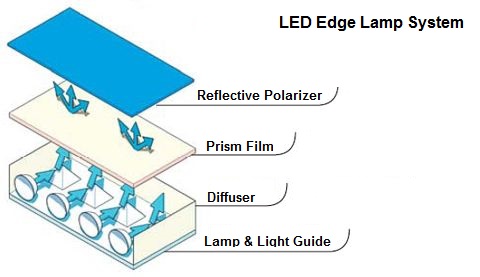
Above you see how a set of LED lights at the edge of the display can be made to illuminate the entire back of the LCD matrix.
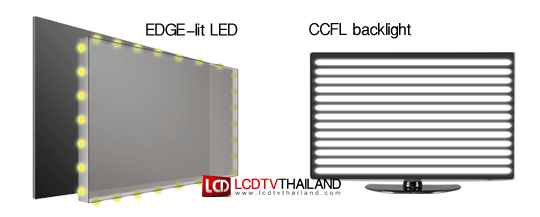

These two images show how LED and CCFL backlighting differ in arrangement.

An organic light-emitting diode (OLED) is a light-emitting diode (LED) in which the emissive electroluminescent layer is a film of organic compound that emits light in response to an electric current.
Since OLED’s pixels actually produce their own light. OLED’s pixels are called ‘emissive’. What this means is that the brightness of an OLED display is controlled pixel-by-pixel not by varying the cells translucence but the amount of light it generates.
This means no backlight is needed, and like LED monitor backlights only a few volts are required to produce light, instead of hundreds of volts to drive the fluoresent backlight in a regular LCD monitor.
Since no backlight is required OLEDs can be made much thinner that LCD or LED displays.
The current drawback for OLEDs is their lifespan, which is currently 5 to 10 thousand hours. This is because the organic crystal material dims over time.

Above you can see that the blue pixels are much larger in size then red, or green. That is because the blue organic material dims quicker than the other two.